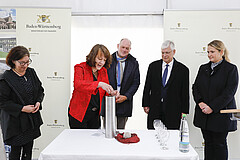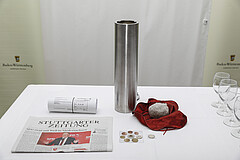For Animal Welfare & Environmental Protection:
State lays cornerstone for new "HoLMiR" research center [11.10.22]
University of Hohenheim’s 52 million euro project pursues new approach in basic research on livestock / Hohenheim Center for Livestock Microbiome Research unique in Europe
More animal welfare and better animal health, more climate protection and less environmental impact: Researchers at the University of Hohenheim in Stuttgart are pursuing these goals with a new approach: They are exploring the interplay between farm animals and the millions of microorganisms in the animals’ digestive tracts. The federal and state governments are supporting the university with the construction of a unique research center for around 52 million euros. Highlights include respiration chambers, which can be used to analyze the composition of the air breathed by adult cows, and high-tech laboratories for gene analysis, molecular biology, and the simulation of differentiated bodily processes. In order to receive the funding, the Hohenheim Center for Livestock Microbiome Research (HoLMiR) had to prevail in a tough competition as a scientific center of supraregional importance according to Art 91b of the German Basic Law. As the base of the building, the foundation stone encloses coins, blueprints, and a Stuttgart newspaper as well as a Bezoar stone. Bezoars are foreign bodies from animal stomachs that were once considered magical healing stones.
In biological terms, every higher living being is a microcosm in itself: The bodies of humans, pigs, chickens, or cows are habitats for billions of microorganisms. In the stomachs and intestines of a single cow, this microbiome comes to a total weight of several kilograms.
These microorganisms even influence the psyche and well-being of farm animals. They are decisive in determining how healthy farm animals are, how well they utilize their food, and what they excrete in terms of climate gases or environmentally harmful substances. In turn, the animals’ diet and behavior influence how the microbiome is composed in their bodies. This creates a complex interaction - with significant consequences for animals, the environment, and the climate.
HoLMir combines expertise on animal nutrition, microbiology, genetics, breeding, behavior...
A research team from the University of Hohenheim set out years ago to explore this interaction and its effects. The team includes experts in animal nutrition, microbiology, genetics, animal breeding, behavior, and animal physiology, among others. Prof. Dr. Markus Rodehutscord is the group’s spokesperson.
The Hohenheim Center for Microbiome Livestock Research (HoLMiR), the cornerstone of which was ceremoniously laid today, will now provide these researchers, early career researchers, and students with facilities that are unique in Europe.
In fact, HoLMiR is two buildings with about 3,500 square meters of usable space:

Coins from the donors: State Secretary Gisela Splett (Ministry of Finance BaWü) deposits euro coins into a time capsule for the foundation stone of the future animal science research center HoLMiR. The capsule also included construction plans and a current daily newspaper, deposited by Ministerial Director Dr. Hans J. Reiter (Ministry of Science BaWü, to the right of Splett), the Hohenheim guidelines for animal experiments, deposited by University President Prof. Dr. Stephan Dabbert (to the right of Reiter), and a Bezoar stone, deposited by agricultural scientist Prof. Dr. Jana Seifert (to the right of Dabbert). Bezoars are balls of animal hair and other foreign bodies that accumulate in animals’ stomachs. Pictured on the left: Carmen Zinnecker-Busch, from the Stuttgart and Hohenheim University Building Office. Image: University of Hohenheim/Beqiri
- The laboratory and institute building (Module I) houses the high-tech park of large-scale equipment. This includes, for example, a laser scanning microscope that enables three-dimensional structural analysis of body tissue. Thanks to high-throughput technology, the genetic material of up to 10,000 cells or microorganisms can be captured every second. The researchers can also simulate body processes in artificial and real organs.
- The animal experimentation unit (Module II) provides housing and infrastructure for up to 250 cattle, sheep, pigs, and poultry according to the most modern animal welfare standards. Another unique feature are the respiration chambers, in which a whole cow can stay so that scientists can investigate the composition of the respiratory air with different feed variants, for example.
More information about the main research areas of HoLMiR and the participating scientists can be found in the attached background and at https:\\holmir.uni-hohenheim.de
Research on animals and for animals
To some extent, laboratory testing makes it possible to replace or reduce animal testing. However, even HoLMiR's research cannot completely dispense with animal testing.
Animal experiments include, for example, the observation of animal behavior, the collection of blood samples, or temporary confinement in special cages where feces and urine are collected. Some experiments make it necessary to slaughter the farm animals at the end of the experiment so that the carcasses or intestinal contents can be examined.
The "fistulated cows” are also a way to reduce larger interventions. Similar to an artificial bowel outlet, access to the rumen is inserted into the flank of these animals. This "fistula" allows samples to be taken from the animals’ rumen over many years without harming them. In most cases, the test animals reach an advanced age and live a life that otherwise differs little from that of another cow kept in the stable.
More about animal experiments at the University of Hohenheim and the Hohenheim Guidelines for Animal Experiments can be found at https://www.uni-hohenheim.de/en/animal-experiments
Thanks to excellent researchers and the federal and state government
"The thanks for laying the foundation stone for this unique center today go to two groups of people in particular: the scientists who have held their own in a very tough competition thanks to their excellence, and the state of Baden-Württemberg, which always believed in our innovative research approach and supported us for years in building up the expertise and research infrastructure," stated University of Hohenheim President Prof. Dr. Stephan Dabbert.
"I'm glad that construction is now underway after the long planning and permit process. Our construction management implements the researchers’ tailored usage requirements. And in terms of energy, the state is also living up to its role model function with these measures. Photovoltaic surfaces of around 600 square meters with an output of around 105 kilowatt peak (kWp) will be installed on both buildings," said State Secretary Gisela Splett of the Baden-Württemberg Ministry of Finance
"The University of Hohenheim is Germany's leading university in the field of agricultural sciences and is therefore the ideal location for the new research center. The future research center will not only bring important advances in microbiome research in farm animals, but will also strengthen the university's research excellence far beyond the state's borders," said Ministerial Director Dr. Hans J. Reiter of the Ministry of Science, Research and the Arts of the state of Baden-Württemberg.
Time capsule with guidelines and a magic stone
The participants of the ceremony sealed a time capsule in the foundation stone. Inside are, among other things, construction plans, coins, and a Stuttgart newspaper from that day.
University President Prof. Dr. Dabbert and HolMiR researcher Prof. Dr. Jana Seifert added two special features: the Hohenheim guidelines for animal experiments as the basis for the research work and a bezoar stone, which was once said to have magical properties among alchemists.
Scientifically, a bezoar is a fist-sized ball of hair that has accumulated in an animal's stomach and solidified over time. Bezoar stones were considered a cure for poisoning and found their way into two Harry Potter volumes in this role.
"In the past, people were fascinated by things they couldn't explain. Today, we are fascinated by the explanations we come up with through science," said Prof. Dr. Rodehutscord, spokesperson for the HoLMiR researchers. “I'm very grateful for the big boost that science will get with the new center."
BACKGROUND: HoLMiR construction project
The new buildings of the Hohenheim Center for Livestock Microbiome Research (HoLMiR) will have a total area of about 3,500 sqm. They serve as a platform for the work of 10 research groups and 3 junior research groups with a total of 40 scientific and 20 non-scientific staff members.
The first development work started in March 2022. The planned handover of the buildings is targeted for 2024. The total budgeted construction costs for both buildings amounted to around 52 million euros. In addition, there is EUR 3 million for initial equipment and EUR 4 million for large equipment.
The new building became possible because the HoLMiR project prevailed in the internationally reviewed competition as a scientific center of supraregional importance according to Art 91b of the Basic Law. Accordingly, the federal government is contributing 23.3 million euros. Further information about HoLMiR and the participating scientists can be found at https:\\holmir.uni-hohenheim.de
BACKGROUND: Animal experiments in Hohenheim
The University of Hohenheim seeks to gain and disseminate knowledge to benefit all life and to protect our planet. For the foreseeable future, this will not be possible without research and teaching with animals. At the University of Hohenheim, this mainly concerns mice and farm animals.
In 2020, the University of Hohenheim reported a total of 3,500 completed animal experiments. 89% of the animal experiments had a mild degree of severity such as blood being drawn. 2% had moderate severity and 1% had high severity. In 8%, the experimental animals were killed, e.g., to remove organs.
The most common experimental animals were chickens (66%), followed by other poultry (14.3%) and mice (9.6%). In addition, there are pigs (6.7%), frogs (2.2%), rats (0.9%), sheep (0.3%), and Mongolian gerbils (0.1%). The statistics for the year 2021 are in preparation.
More information can be found at https://www.uni-hohenheim.de/en/animal-experiments

Time capsule for the foundation stone of the future animal science research center HoLMiR: Prof. Dr. Jana Seifert deposits a bezoar stone into the steel cylinder. Bezoars are balls of animal hair and other foreign bodies that accumulate in animals’ stomachs. The capsule also included coins, deposited by State Secretary Gisela Splett (Ministry of Finance BaWü, wearing a red jacket), building plans and a current daily newspaper, deposited by Ministerial Director Dr. Hans J. Reiter (Ministry of Science BaWü, to the right of Splett), and the Hohenheim guidelines for animal experiments, deposited by University President Prof. Dr. Stephan Dabbert (to the right of Reiter). Pictured on the left: Carmen Zinnecker-Busch, from the Stuttgart and Hohenheim University Building Office. Image: University of Hohenheim/Beqiri

Research for more animal welfare and better animal health, more climate protection and less environmental impact: These are the goals of the future animal science center "HoLMiR". The focus is on exploring the interaction between farm animals and the millions of microorganisms in the animals’ digestive tracts. Photos: University of Hohenheim
Dauphin(2) + Emmerling(1)
Text: Klebs
Contact for press:
Prof. Dr. Markus Rodehutscord, University of Hohenheim, Institute of Animal Science
T +49 (0)711 459 22420, E markus.rodehutscord@uni-hohenheim.de
Prof. Dr. Jana Seifert, University of Hohenheim, Institute of Animal Science
T +49 (0)711 459 24284, E seifert.jana@uni-hohenheim.de





